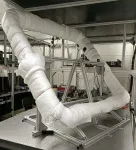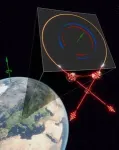(Press-News.org) A team of researchers led by Philip Walther at the University of Vienna carried out a pioneering experiment where they measured the effect of the rotation of Earth on quantum entangled photons. The work, just published in Science Advances, represents a significant achievement that pushes the boundaries of rotation sensitivity in entanglement-based sensors, potentially setting the stage for further exploration at the intersection between quantum mechanics and general relativity.
Optical Sagnac interferometers are the most sensitive devices to rotations. They have been pivotal in our understanding of fundamental physics since the early years of the last century, contributing to establish Einstein’s special theory of relativity. Today, their unparalleled precision makes them the ultimate tool for measuring rotational speeds, limited only by the boundaries of classical physics.
Interferometers employing quantum entanglement have the potential to break those bounds. If two or more particles are entangled, only the overall state is known, while the state of the individual particle remains undetermined until measurement. This can be used to obtain more information per measurement than would be possible without it. However, the promised quantum leap in sensitivity has been hindered by the extremely delicate nature of entanglement. Here is where the Vienna experiment made the difference. They built a giant optical fiber Sagnac interferometer and kept the noise low and stable for several hours. This enabled the detection of enough high-quality entangled photon pairs such to outperform the rotation precision of previous quantum optical Sagnac interferometers by a thousand times.
In a Sagnac interferometer, two particles travelling in opposite directions of a rotating closed path reach the starting point at different times. With two entangled particles, it becomes spooky: they behave like a single particle testing both directions simultaneously while accumulating twice the time delay compared to the scenario where no entanglement is present. This unique property is known as super-resolution. In the actual experiment, two entangled photons were propagating inside a 2-kilometer-long optical fiber wounded onto a huge coil, realizing an interferometer with an effective area of more than 700 square meters.
A significant hurdle the researchers faced was isolating and extracting Earth's steady rotation signal. "The core of the matter," explains lead author Raffaele Silvestri, "lays in establishing a reference point for our measurement, where light remains unaffected by Earth's rotational effect. Given our inability to halt Earth's from spinning, we devised a workaround: splitting the optical fiber into two equal-length coils and connecting them via an optical switch". By toggling the switch on and off the researchers could effectively cancel the rotation signal at will, which also allowed them to extend the stability of their large apparatus. "We have basically tricked the light into thinking it's in a non-rotating universe", says Silvestri.
The experiment, which was conducted as part of the research network TURIS hosted by the University of Vienna and the Austrian Academy of Sciences, has successfully observed the effect of the rotation of Earth on a maximally entangled two-photon state. This confirms the interaction between rotating reference systems and quantum entanglement, as described in Einstein's special theory of relativity and quantum mechanics, with a thousand-fold precision improvement compared to previous experiments. "That represents a significant milestone since, a century after the first observation of Earth’s rotation with light, the entanglement of individual quanta of light has finally entered the same sensitivity regimes", says Haocun Yu, who worked on this experiment as a Marie-Curie Postdoctoral Fellow. "I believe our result and methodology will set the ground to further improvements in the rotation sensitivity of entanglement-based sensors. This could open the way for future experiments testing the behavior of quantum entanglement through the curves of spacetime", adds Philip Walther.
END
Quantum entanglement measures Earth rotation
Quantum entangled photons react to Earth’s spin
2024-06-14
ELSE PRESS RELEASES FROM THIS DATE:
New rapid detection of bacteria in pediatric blood samples
2024-06-14
Atlanta, Ga. – June 14, 2023 – Researchers have demonstrated that a new technology could quickly and accurately diagnose bloodstream infections. The study findings were reported at ASM Microbe, the annual meeting of the American Society for Microbiology.
“There is a need to be able to rapidly and accurately diagnose bacteremia in newborn babies. They are especially susceptible to long-term morbidities and mortality the longer they go without treatment, or even with inaccurate treatment for bloodstream infections or sepsis,” said presenting study author April Aralar, Ph.D., a ...
Ex vivo gene editing and cell therapy for hereditary tyrosinemia type 1
2024-06-14
Background: We previously demonstrated the successful use of in vivo CRISPR gene editing to delete 4-hydroxyphenylpyruvate dioxygenase (HPD) to rescue mice deficient in fumarylacetoacetate hydrolase (FAH), a disorder known as hereditary tyrosinemia type 1 (HT1). The aim of this study was to develop an ex vivo gene-editing protocol and apply it as a cell therapy for HT1.
Methods: We isolated hepatocytes from wild-type (C57BL/6J) and Fah-/- mice and then used an optimized electroporation protocol to deliver Hpd-targeting CRISPR-Cas9 ribonucleoproteins into hepatocytes. Next, hepatocytes were transiently incubated in ...
Intranasal COVID-19 vaccine headed to clinical trials
2024-06-14
University of Georgia-based startup CyanVac LLC received federal funding to support a comparative Phase 2b clinical trial of CVXGA, the company’s intranasal vaccine candidates designed to protect against COVID-19.
As part of the award from Project NextGen, a federal initiative based in the U.S. Department of Health and Human Services (HHS), CyanVac will sponsor a randomized, double-blind Phase 2b study with 10,000 participants to compare the efficacy and safety of the intranasal vaccine against an FDA-approved mRNA-based COVID-19 vaccine.
The new vaccine is based on a viral delivery platform developed by He containing modified ...
High out-of-pocket costs may be barrier to filling naloxone prescriptions, study shows
2024-06-14
Patients are less likely to fill prescriptions for naloxone when they face increases in out-of-pocket costs, according to U-M researchers.
Patients are less likely to fill prescriptions for naloxone when they face increases in out-of-pocket costs, according to research by the University of Michigan.
Published in the Journal of the American Medical Association, the study utilized data from a national pharmacy transactions database from November 2020 to March 2021. Researchers found that about 1 in 3 naloxone ...
Sharks have depleted functional diversity compared to the last 66 million years
2024-06-14
New research by Swansea University and the University of Zurich has found that sharks retained high levels of functional diversity for most of the last 66 million years, before steadily declining over the last 10 million years to its lowest value in the present day.
Modern sharks are among the ocean’s most threatened species; yet have notably survived numerous environmental changes in their 250-million-year history. Today, their more than 500 species play many different ecological roles, from apex predators to nutrient transporters.
Ecological roles are determined by species’ traits such as body size, ...
Fasting primes the immune system’s natural killer cells to better fight cancer, new study in mice finds
2024-06-14
Periods of fasting reprogram the immune system’s natural killer cells to better fight cancer, according to a new study in mice from researchers at Memorial Sloan Kettering Cancer Center (MSK).
Fasting and other dietary regimens are increasingly being explored as ways to starve cancer cells of the nutrients they need to grow and to make cancer treatments more effective.
Now a team of researchers from MSK’s Sloan Kettering Institute and their collaborators have shown for the ...
Are patient partners a necessity in research?
2024-06-14
Sjögren’s disease is a systemic autoimmune disorder that often causes sicca symptoms – or dryness of the eyes and mouth, alongside many other complications such as fatigue, pain, and neurological manifestations. There are treatments that help with symptoms, but none that address the underlying disease processes.3 One key issue in developing new treatments is that Sjögren’s can differ from person to person – and that makes it hard to measure and compare outcomes in a clinical trial.
NECESSITY is an interventional trial looking at new clinical endpoints in Sjögren’s disease. ...
Encouraging cooperation in inflammatory arthritis
2024-06-14
Inflammatory arthritis describes a group of diseases caused by an overactive immune system. The different types of inflammatory arthritis include rheumatoid arthritis, psoriatic arthritis, juvenile idiopathic arthritis, and ankylosing spondylitis. The most common symptoms are joint pain and stiffness. Pain is the predominant symptom in the majority of people with inflammatory arthritis, which contributes to the global burden of rheumatic and musculoskeletal conditions.1 Knowledgeable support can reduce ...
Protection against disease and treatment toxicity
2024-06-14
Autologous hematopoietic stem cell transplantation (aHSCT) for SSc has been proven the most effective treatment strategy with regard to overall and event free survival in selected patients.2 But a key limitation is its toxicity, and new treatment options are needed. Two abstracts presented at the 2024 EULAR congress in Vienna focused on novel approaches.
Jörg Henes presented on behalf of the AST MOMA investigators. This prospective, open-label, study evaluated the feasibility of aHSCT in patients with impaired lung or heart function, and also ...
Does BMO induced by mechanical stress progress to structural lesions?
2024-06-14
BMO in the sacroiliac joint on MRI is present in up to 84% of people with non-radiographic axSpA – but it is also often seen in a non-inflammatory setting, such as in women after childbirth.1,2 As back pain is common after childbirth, differential diagnosis with axSpA is an important issue in clinical practice.1 In axSpA, active inflammatory lesions are likely to progress to structural lesions over time – particularly fat lesions and erosions. But it is not known whether the same is true for BMO induced by mechanical stress. In June 2024, EULAR – The European Alliance of Associations for Rheumatology – held its annual congress ...
LAST 30 PRESS RELEASES:
AI overestimates how smart people are, according to HSE economists
HSE researchers create genome-wide map of quadruplexes
Scientists boost cell "powerhouses" to burn more calories
Automatic label checking: The missing step in making reliable medical AI
Low daily alcohol intake linked to 50% heightened mouth cancer risk in India
American Meteorological Society announces Rick Spinrad as 2026 President-Elect
Biomass-based carbon capture spotlighted in newly released global climate webinar recording
Illuminating invisible nano pollutants: advanced bioimaging tracks the full journey of emerging nanoscale contaminants in living systems
How does age affect recovery from spinal cord injury?
Novel AI tool offers prognosis for patients with head and neck cancer
Fathers’ microplastic exposure tied to their children’s metabolic problems
Research validates laboratory model for studying high-grade serous ovarian cancer
SIR 2026 delivers transformative breakthroughs in minimally invasive medicine to improve patient care
Stem Cell Reports most downloaded papers of 2025 highlight the breadth and impact of stem cell research
Oxford-led study estimates NHS spends around 3% of its primary and secondary care budget on the health impacts of heat and cold in England
A researcher’s long quest leads to a smart composite breakthrough
Urban wild bees act as “microbial sensors” of city health.
New study finds where you live affects recovery after a hip fracture
Forecasting the impact of fully automated vehicle adoption on US road traffic injuries
Alcohol-related hospitalizations from 2016 to 2022
Semaglutide and hospitalizations in patients with obesity and established cardiovascular disease
Researchers ‘listen in’ to embryo-mother interactions during implantation using a culture system replicating the womb lining
How changing your diet could help save the world
How to make AI truly scalable and reliable for real-time traffic assignment?
Beyond fragmented markets: A new framework for efficient and stable ride-pooling
Can shape priors make road perception more reliable for autonomous driving?
AI tracks nearly 100 years of aging research, revealing key trends and gaps
Innovative techniques enable Italy’s first imaging of individual trapped atoms
KIER successfully develops Korea-made “calibration thermoelectric module” for measuring thermoelectric device performance
Diversifying US Midwest farming for stability and resilience
[Press-News.org] Quantum entanglement measures Earth rotationQuantum entangled photons react to Earth’s spin



